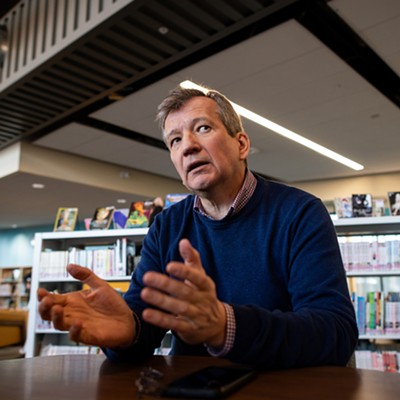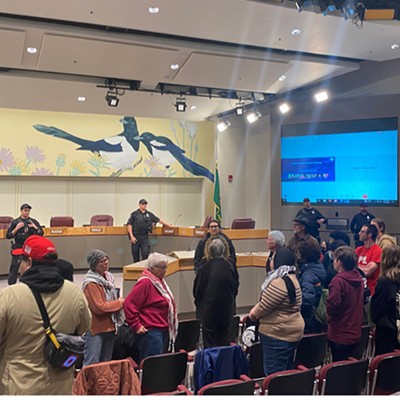A drive down Bigelow Gulch Road is a sight to behold. On either side of the winding road, rolling hills slowly pass by, dotted with the area's historic farmhouses. Dirt driveways pull away from the rural road, leading through pastureland to the occasional loose, barking dog or a rooster and his brood. Orchard Prairie School, a one-room schoolhouse built in 1879, still harbors young students every school day and the local grange still hosts community meetings.
Then there's that road. As a major connector between North Spokane and Spokane Valley, stretches of Bigelow Gulch Road see about 10,000 cars a day. Traffic hugs both the white and yellow lines, pushed together on a two-lane road badly in need of an update. The speed limit is 45 mph for most of the six miles between the road's intersections with Havana Street and Forker Road, but that doesn't prevent the feeling of doom when a semi-truck flies by in the opposite direction.
"For years this road has needed improving," says Don Hamilton, a longtime resident of Orchard Prairie (and a professional photographer who contributes to The Inlander). But now that Spokane County is moving ahead with a plan to widen the thoroughfare -- by adding another lane in either direction, a median lane and eight-foot shoulders -- Hamilton is calling foul. "If (the county's plan) is what it needs to be, study it as such and execute it as such. (But the county) is betting that they can complete the North-South highway for pennies on the dollar. And that's what they're doing right now."
On Friday, Hamilton filed a motion in federal court to stop any and all work on the project. Hamilton's partner, Lorna St. John, as well as resident Quentin Wood and the Prairie Protection Association join him in the complaint. The chief reason for the suit: the "de facto" completion of the southern half of the North Spokane Corridor without a proper environmental study.
Looking at a map, it seems to make sense. The almost completed first phase of the North Spokane Corridor highway terminates right where Bigelow Gulch's construction is to begin. From there the Bigelow Gulch corridor heads east, then meets with I-90 near the Spokane Valley Mall. Also, the estimated final cost of the corridor highway, considering a 20-year build scenario and inflation, is $3.3 billion. The projected cost of revamping Bigelow Gulch is just $54 million. But transportation officials say Hamilton and his crew are way off.
"We conceived of this plan in the mid-'90s," says the project's manager, Chad Coles. "If you look at it, this is a truly different facility," Coles adds, comparing Bigelow Gulch to the corridor highway. The intersection of the two roads is "coincidental," he says, adding that estimates show the relative placement of the roads will have no impact on the their traffic counts.
Larry Larson, project engineer for the North Spokane Corridor, also denies that Bigelow Gulch is a completion of the corridor highway on the cheap. "(The construction projects) serve two different purposes but they are complementary. ... It makes sense for that facility to work in harmony with ours, but it wasn't some grand scheme to make sure that we were connected to Bigelow." Scheme or not, Larson says the connection is there and will continue. The purpose of the corridor highway will be to ferry traffic from North Spokane to I-90. Bigelow Gulch delivers vehicles from North Spokane to Spokane Valley. "Will traffic get off the (corridor highway) and turn left to head down Bigelow Gulch? Absolutely," says Larson. "That's already happening."
The stated reason for the update on Bigelow Gulch -- safety -- is not a point of contention. Everyone involved acknowledges the need for the road's modernization. Between 1994 and 2006, there were an average of 37 accidents per year on the road between Havana and Forker. In those 12 years, 189 injuries occurred and six people were killed. But Hamilton says the work is more a threat to the community than its residents' health. "The real issue is that it will be the end of the Orchard Prairie community. ... It's not as if I've discovered a nuclear waste dump, but it is a clear and present danger."
In the complaint, Hamilton and the others want a federal judge to stop any work being done on the project until a full Environmental Impact Statement is performed. In April, the county conducted an Environmental Assessment and found no "significant impact." As part of its preliminary studies for the North Spokane Corridor, WSDOT performed a full-fledged Environmental Impact Statement, a type of study that is much more detailed than the Environmental Assessment. Hamilton says if the road is going to act as the southern half of the corridor highway, the same wide-ranging study should be done.
"This is in essence going to be, for the foreseeable future, the de facto connector for the North-South freeway," says Rick Eichstaedt, a lawyer at Spokane's Center For Justice, which is handling Hamilton's case. "The neighborhood would certainly like to have the full facts examined and have the chance to engage in any sort of mitigation. ... It might make sense, once you have the whole picture, to not go ahead with the project."
For his part, Hamilton says he cannot accept the road temporarily acting as a connector. "Temporarily? Are you going to roll it up and pack it off when you're done with it?"

























